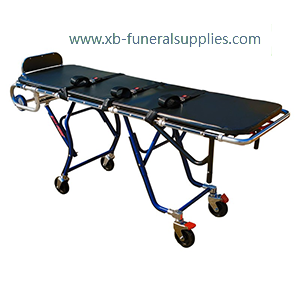-


-
Funeral Dead Body Stretcher Transport Mortuary Trolley
After arriving at the body storage area or funeral home, adjust the lifting device of the transport vehicle again according to the height of the receiving platform (such as refrigerated cabinets, autopsy tables, etc.) to adjust the carrying platform to the appropriate height, so as to smoothly transfer the body to the receiving platform.
-
0.000.00
-
After arriving at the body storage area or funeral home, adjust the lifting device of the transport vehicle again according to the height of the receiving platform (such as refrigerated cabinets, autopsy tables, etc.) to adjust the carrying platform to the appropriate height, so as to smoothly transfer the body to the receiving platform.
Contrary to the operation of placing the body, multiple operators coordinated and cooperated to gently transfer the body from the carrying platform of the transport vehicle to the receiving platform. Transfer tools can also be used to assist in the operation, ensuring a smooth and safe transfer process. Cleaning the moving vehicle After completing the body transportation, clean and disinfect the transport vehicle. Use appropriate disinfectants to wipe and disinfect the carrying platform, fixing devices, and other parts of the transport vehicle to remove possible bacteria and pollutants. At the same time, clean the debris and dust on the transport vehicle to maintain its cleanliness and hygiene. 3、 Post use maintenance (1) Cleaning and maintenance Vehicle cleaning Clean the body surface of the transport vehicle with clean water and neutral detergent to remove dust, stains, etc. For stubborn stains, a soft bristled brush can be used to gently scrub, but care should be taken to avoid scratching the surface of the vehicle. After cleaning, dry the car body with a clean towel to prevent moisture residue from causing rust. Internal cleaning Regularly clean the interior of the transport vehicle, including dust and debris on the lifting device, transmission components, and other parts. Compressed air or a small brush can be used for cleaning to ensure the normal operation of these components. (2) Component inspection and replacement regular inspection Establish a regular inspection system to inspect various components of the transport vehicle, including wheels, bearings, lifting devices, fixing devices, etc. Check whether the components are worn, aged, damaged, etc. If any problems are found, they should be repaired or replaced in a timely manner. Replacement of vulnerable parts For some vulnerable parts, such as tires, straps, etc., they should be replaced in a timely manner according to their usage and wear level. Generally speaking, tires should be replaced when they have been used for a certain mileage or when there is obvious wear or tear; If the elasticity of the straps decreases or breaks after a period of use, they should be replaced in a timely manner to ensure the safety and reliability of the transport vehicle. (3) Storage requirements Dry and ventilated Store the transport vehicle in a dry and ventilated place to prevent the vehicle from getting damp and rusting. If the storage environment is relatively humid, a layer of rust proof oil can be applied to the surface of the vehicle for protection. Avoid squeezing When storing, ensure that the transport vehicle is not compressed to avoid deformation of the body. The transport vehicle can be placed on a dedicated storage rack or flat ground to maintain its stable state.

Wooden coffin
Metal Caskets
tombstone
Funeral equipment
Urn
cinerary casket
Hebei Xubing International Trade Co., Ltd
Room 101, Unit 5, Building 4, Five-Star Industrial Park, No. 120 Wind Energy Street, Baoding







